
A | B | C | D | E | F | G | H | CH | I | J | K | L | M | N | O | P | Q | R | S | T | U | V | W | X | Y | Z | 0 | 1 | 2 | 3 | 4 | 5 | 6 | 7 | 8 | 9
This article has multiple issues. Please help improve it or discuss these issues on the talk page. (Learn how and when to remove these template messages)
|
| This article is part of a series on the |
| Culture of the United States |
|---|
 |
| Society |
| Arts and literature |
| Other |
| Symbols |
|
United States portal |
The culture of the United States of America, also referred to as American culture, encompasses various social behaviors, institutions, and norms in the United States, including forms of speech, literature, music, visual arts, performing arts, food, sports, religion, law, technology as well as other customs, beliefs, and forms of knowledge. American culture has been shaped by the history of the United States, its geography, and various internal and external forces and migrations.[1]
Its Western foundations are primarily English-influenced, with prominent German, Italian, Spanish, Asian, African, Polish, Jewish, Indigenous, French, and Scandinavian regional influences. Since the United States was established in 1776, its culture has been influenced by successive waves of immigrants, and the resulting "melting pot" of cultures has been a distinguishing feature of its society. Americans pioneered or made great strides in musical genres such as heavy metal, rhythm and blues, jazz, gospel, country, hip hop, and rock 'n' roll. The "big four sports" are American football, baseball, basketball, and ice hockey. In terms of religion, the vast majority of Americans are Protestant, Catholic, or irreligious. American cuisine includes popular tastes such as hot dogs, milkshakes, and barbecue, as well as many other class and regional preferences. The national language is English. Distinct cultural regions include New England, Mid-Atlantic, the South, Midwest, Southwest, Mountain West, and Pacific Northwest.[2]
Politically, the country takes its values from the American Revolution and American Enlightenment, with an emphasis on liberty, individualism, and limited government, as well as the Bill of Rights and Reconstruction Amendments. Under the First Amendment, the United States has the strongest protections of free speech of any country.[3][4][5][6] American popular opinion is also the most supportive of free expression and the right to use the Internet.[7][8] The large majority of the United States has a legal system that is based upon English common law.[9] According to the Inglehart–Welzel cultural map, it leans greatly towards "self-expression values", while also uniquely blending aspects of "secular-rational" (with a strong emphasis on human rights, the individual, and anti-authoritarianism) and "traditional" (with high fertility rates, religiosity, and patriotism) values together.[10][11][12] Its culture can vary by factors such as region, race and ethnicity, age, religion, socio-economic status, or population density, among others. Different aspects of American culture can be thought of as low culture or high culture, or belonging to any of a variety of subcultures. The United States exerts major cultural influence on a global scale and is considered a cultural superpower.[13][14]
History
Origins, development, and spread

The European roots of the United States originate with the English and Spanish settlers of colonial North America during British and Spanish rule. The varieties of English people, as opposed to the other peoples on the British Isles, were the overwhelming majority ethnic group in the 17th century (the population of the colonies in 1700 was 250,000) and were 47.9% of percent of the total population of 3.9 million. They constituted 60% of the whites at the first census in 1790 (%: 3.5 Welsh, 8.5 Scotch Irish, 4.3 Scots, 4.7 Irish, 7.2 German, 2.7 Dutch, 1.7 French, and 2 Swedish).[15] [citation needed]The English ethnic group contributed to the major cultural and social mindset and attitudes that evolved into the American character. Of the total population in each colony, they numbered from 30% in Pennsylvania to 85% in Massachusetts.[16] Large non-English immigrant populations from the 1720s to 1775, such as the Germans (100,000 or more), Scotch Irish (250,000), added enriched and modified the English cultural substrate.[17] The religious outlook was some versions of Protestantism (1.6% of the population comprised English, German, and Irish Catholics).[citation needed]
Jeffersonian democracy was a foundational American cultural innovation, which is still a core part of the country's identity.[18] Thomas Jefferson's Notes on the State of Virginia was perhaps the first influential domestic cultural critique by an American and was written in reaction to the views of some influential Europeans that America's native flora and fauna (including humans) were degenerate.[18]

Major cultural influences have been brought by historical immigration, especially from Germany in much of the country,[19] Ireland and Italy in the Northeast, Japan in Hawaii. Latin American culture is especially pronounced in former Spanish areas but has also been introduced by immigration, as have Asian American cultures (especially in the Northeast and West Coast regions). Caribbean culture has been increasingly introduced by immigration and is pronounced in many urban areas. Since the abolition of slavery, the Caribbean has been the source of the earliest and largest Black immigrant group, a significant source of growth of the Black population in the U.S. and has made major cultural impacts in education, music, sports and entertainment.[20]
Native culture remains strong in areas with large undisturbed or relocated populations, including traditional government and communal organization of property now legally managed by Indian reservations (large reservations are mostly in the West, especially Arizona and South Dakota). The fate of native culture after contact with Europeans is quite varied. For example, Taíno culture in U.S. Caribbean territories is nearly extinct and like most Native American languages, the Taíno language is no longer spoken. By contrast, the Hawaiian language and culture of the Native Hawaiians has survived in Hawaii and mixed with that of immigrants from the mainland U.S. (starting before the 1898 annexation) and to some degree Japanese immigrants. It occasionally influences mainstream American culture with notable exports like surfing and Hawaiian shirts. Most languages native to what is now U.S. territory have gone extinct,[21] and the economic and mainstream cultural dominance of the English language threatens the surviving ones in most places. Some of the most common native languages include Samoan, Hawaiian, Navajo, Cherokee, Sioux, and a spectrum of Inuit languages. (See Indigenous languages of the Americas for a fuller listing, plus Chamorro, and Carolinian in the Pacific territories.)[22][better source needed] Ethnic Samoans are a majority in American Samoa; Chamorro are still the largest ethnic group in Guam (though a minority), and along with Refaluwasch are smaller minorities in the Northern Mariana Islands.[citation needed]

American culture includes both conservative and liberal elements, scientific and religious competitiveness, political structures, risk taking and free expression, materialist and moral elements. Despite certain consistent ideological principles (e.g. individualism, egalitarianism, and faith in freedom and republicanism), American culture has a variety of expressions due to its geographical scale and demographics.[23]
As a melting pot of cultures and ethnicities, the U.S. has been shaped by the world's largest immigrant population. The country is home to a wide variety of ethnic groups, traditions, and values,[24][25] and exerts major cultural influence on a global scale, with the phenomenon being termed Americanization.[26][27][13][14]
Regional variations

Semi-distinct cultural regions of the United States include New England, the Mid-Atlantic, the South, the Midwest, the Southwest, and the West—an area that can be further subdivided into the Pacific States and the Mountain States.[citation needed]
According to cultural geographer Colin Woodward there are as many as eleven cultural areas of the United States, which spring from their settlement history. In the east from North to South: there are Puritan areas ("Yankeedom") of New England which spread across the northern Great Lakes to the northern reaches of the Mississippi and Missouri Rivers; the New Netherlands area in the densely populated New York Metropolitan Area; the Midland area which spread from Pennsylvania to the lower Great Lakes and the trans-Mississippi upper midwest; Greater Appalachia which angles from West Virginia through the lower midwest and upper-south to trans-Mississippi Arkansas, and southern Oklahoma; the Deep South from the Carolinas to Florida and west to Texas. In the west, there is the southwestern "El Norte" areas originally colonized by Spain, the "Left Coast" colonized quickly on the 19th century by a mix of Yankees and upper Appalachians, and the large but sparsely populated interior West.[28][29]
The west coast of the continental United States, consisting of California, Oregon, and Washington state, is also sometimes referred to as the Left Coast, indicating its left-leaning political orientation and tendency towards social liberalism.[citation needed]
The South is sometimes informally called the "Bible Belt" due to socially conservative evangelical Protestantism, which is a significant part of the region's culture. Christian church attendance across all denominations is generally higher there than the national average. This region is usually contrasted with the mainline Protestantism and Catholicism of the Northeast, the religiously diverse Midwest and Great Lakes, the Mormon Corridor in Utah and southern Idaho, and the relatively secular West. The percentage of non-religious people is the highest in the northeastern and New England state of Vermont at 34%, compared to 6% in the Bible Belt state of Alabama.[30]
Strong cultural differences have a long history in the U.S., with the southern slave society in the antebellum period serving as a prime example. Social and economic tensions between the Northern and Southern states were so severe that they eventually caused the South to declare itself an independent nation, the Confederate States of America; thus initiating the American Civil War.[31]
Cultures of regions in the United States
- Culture of New England
- Culture of the Southern United States
- Culture of the Midwest
- Culture of Western United States
- Appalachian Culture
Language

Although the United States has no official language at the federal level, 28 states have passed legislation making English the official language, and it is considered to be the de facto national language. According to the 2000 U.S. Census, more than 97% of Americans can speak English well, and for 81%, it is the only language spoken at home. The national dialect is known as American English, which itself consists of numerous regional dialects, but has some shared unifying features that distinguish it from British English and other varieties of English. There are four large dialect regions in the United States—the North, the Midland, the South, and the West—and several dialects more focused within metropolitan areas such as those of New York City, Philadelphia, and Boston. A standard dialect called "General American" (analogous in some respects to the received pronunciation elsewhere in the English-speaking world), lacking the distinctive noticeable features of any particular region, is believed by some to exist as well; it is sometimes regionally associated with the Midwest. American Sign Language, used mainly by the deaf, is also native to the United States.[citation needed]
More than 300 languages nationwide, and up to 800 languages in New York City, besides English, have native speakers in the United States—some are spoken by indigenous peoples (about 150 living languages) and others imported by immigrants. English is not the first language of most immigrants in the US, though many do arrive knowing how to speak it, especially from countries where English is broadly used.[32] This not only includes immigrants from countries such as Canada, Jamaica, and the UK, where English is the primary language, but also countries where English is an official language, such as India, Nigeria, and the Philippines.[32]
According to the 2000 census, there are nearly 30 million native speakers of Spanish in the United States. Spanish has official status in the Commonwealth of Puerto Rico, where it is the primary language spoken, and the state of New Mexico; various smaller Spanish enclaves exist around the country as well.[33] Bilingual speakers may use both English and Spanish reasonably well and may code-switch according to their dialog partner or context, a phenomenon known as Spanglish.[citation needed]
Indigenous languages of the United States include the Native-American languages (including Navajo, Yupik, Dakota, and Apache), which are spoken on the country's numerous Indian reservations and at cultural events such as pow wows; Hawaiian, which has official status in the state of Hawaii; Chamorro, which has official status in the commonwealths of Guam and the Northern Mariana Islands; Carolinian, which has official status in the commonwealth of the Northern Mariana Islands; and Samoan, which has official status in the commonwealth of American Samoa.
| Language | Percentage of the total population |
|---|---|
| English only | 78.2% |
| Spanish | 13.4% |
| Chinese | 1.1% |
| Other | 7.3% |
Customs and traditions
Cuisine
The cuisine of the United States is extremely diverse, owing to the vastness of the country, the relatively large population (1⁄3 of a billion people) and the number of native and immigrant influences. Mainstream American culinary arts are similar to those in other Western countries. Wheat and corn are the primary cereal grains.[citation needed] Traditional American cuisine uses ingredients such as turkey, potatoes, sweet potatoes, corn (maize), squash, and maple syrup, as well as indigenous foods employed by American Indians and early European settlers, African slaves, and their descendants.[citation needed]
Iconic American dishes such as apple pie, donuts, fried chicken, pizza, hamburgers, and hot dogs derive from the recipes of various immigrants and domestic innovations.[35][36] French fries, Mexican dishes such as burritos and tacos, and pasta dishes freely adapted from Italian sources are consumed.[37]
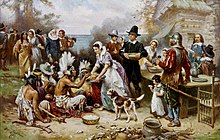
The types of food served at home vary greatly and depend upon the region of the country and the family's own cultural heritage. Recent immigrants tend to eat food similar to that of their country of origin, and Americanized versions of these cultural foods, such as Chinese American cuisine or Italian American cuisine often eventually appear. Vietnamese cuisine, Korean cuisine, and Thai cuisine in authentic forms are often readily available in large cities. German cuisine has a profound impact on American cuisine, especially Midwestern cuisine; potatoes, noodles, roasts, stews, cakes, and other pastries are the most iconic ingredients in both cuisines.[38] Dishes such as the hamburger, pot roast, baked ham, and hot dogs are examples of American dishes derived from German cuisine.[39][40]
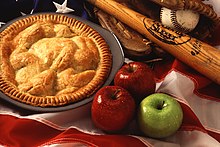
Different regions of the United States have their own cuisine and styles of cooking. The states of Louisiana and Mississippi, for example, are known for their Cajun and Creole cooking. Cajun and Creole cooking are influenced by French, Acadian, and Haitian cooking, although the dishes themselves are original and unique. Examples include Crawfish Étouffée, Red beans and rice, seafood or chicken gumbo, jambalaya, and boudin. Italian, German, Hungarian, and Chinese influences, traditional Native American, Caribbean, Mexican, and Greek dishes have also diffused into the general American repertoire. It is not uncommon for a middle-class family from Middle America to eat, for example, restaurant pizza, home-made pizza, enchiladas con carne, chicken paprikash, beef stroganoff, and bratwurst with sauerkraut for dinner throughout a single week.[citation needed]
Soul food, mostly the same as food eaten by white southerners, developed by southern African slaves, and their free descendants, is popular around the South and among many African Americans elsewhere. Syncretic cuisines such as Louisiana Creole, Cajun, Pennsylvania Dutch, and Tex-Mex are regionally important.
Americans generally prefer coffee to tea, and more than half the adult population drinks at least one cup a day.[41] Marketing by U.S. industries is largely responsible for making orange juice and milk (now often fat-reduced) ubiquitous breakfast beverages.[42] During the 1980s and 1990s, the caloric intake of Americans rose by 24%;[37] and frequent dining at fast food outlets is associated with what health officials call the American "obesity epidemic." Highly sweetened soft drinks are popular; sugared beverages account for 9% of the average American's daily caloric intake.[43]
The American fast food industry, the world's first and largest, is also often viewed as being a symbol of U.S. marketing dominance. Companies such as McDonald's,[44] Burger King, Pizza Hut, Kentucky Fried Chicken, and Domino's Pizza among others, have numerous outlets around the world,[45] and pioneered the drive-through format in the 1940s.[46]
- Some representative American foods
-
Traditional Thanksgiving dinner with turkey, dressing, sweet potatoes, and cranberry sauce
-
A cream-based New England chowder, traditionally made with clams and potatoes
-
Fried chicken, a southern dish consisting of chicken pieces that have been coated with seasoned flour or batter and deep fried
-
Creole Jambalaya with shrimp, ham, tomato, and Andouille sausage
-
Chicken-fried steak (or Country Fried Steak)
-
A submarine sandwich, which includes a variety of Italian luncheon meats
-
American style breakfast with pancakes, maple syrup, sausage links, bacon strips, and fried eggs
-
A hot dog sausage topped with beef chili, white onions and mustard
-
An apple cobbler dessert
Sports
In the 1800s, colleges were encouraged to focus on intramural sports, particularly track and field, and, in the late 1800s, American football. Physical education was incorporated into primary school curriculums in the 20th century.[47]
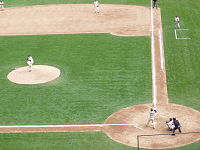
Baseball is the oldest of the major American team sports. Professional baseball dates from 1869 and had no close rivals in popularity until the 1960s. Though baseball is no longer the most popular sport,[48] it is still referred to as "the national pastime." Also unlike the professional levels of the other popular spectator sports in the U.S., Major League Baseball teams play almost every day. The Major League Baseball regular season consists of each of the 30 teams playing 162 games from late March to early October. The season ends with the postseason and World Series in October. Unlike most other major sports in the country, professional baseball draws most of its players from a "minor league" system, rather than from university athletics.
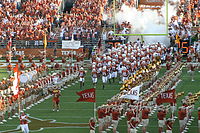
American football, known in the United States as simply "football", now attracts more television viewers than any other sport and is considered to be the most popular sport in the United States.[49] The 32-team National Football League (NFL) is the most popular professional American football league. The National Football League differs from the other three major pro sports leagues in that each of its 32 teams plays one game a week over 18 weeks, for a total of 17 games with one bye week for each team. The NFL season lasts from September to December, ending with the playoffs and Super Bowl in January and February. Its championship game, the Super Bowl, has often been the highest rated television show, and it has an audience of over 100 million viewers annually.[citation needed]
College football also attracts audiences of millions. Some communities, particularly in rural areas, place great emphasis on their local high school football team. American football games usually include cheerleaders and marching bands, which aim to raise school spirit and entertain the crowd at halftime.
Basketball is another major sport, represented professionally by the National Basketball Association. It was invented in Springfield, Massachusetts, in 1891, by Canadian-born physical education teacher James Naismith. College basketball is also popular, due in large part to the NCAA men's Division I basketball tournament in March, colloquially known as "March Madness".
Ice hockey is the fourth-leading professional team sport. Always a mainstay of Great Lakes and New England-area culture, the sport gained tenuous footholds in regions like the American South since the early 1990s, as the National Hockey League pursued a policy of expansion.[50]
Lacrosse is a team sport of American and Canadian Native American origin and is most popular on the East Coast. NLL and MLL are the national box and outdoor lacrosse leagues. Many of the top Division I college lacrosse teams draw upwards of 7–10,000 for a game, especially in the Mid-Atlantic and New England areas.
Soccer is very popular as a participation sport, particularly among youth, and the US national teams are competitive internationally. A twenty-six-team (with four more confirmed to be added within the next few years) professional league, Major League Soccer, plays from March to October, but its television audience and overall popularity lag behind other American professional sports.[51]
Other popular sports are tennis, softball, rodeo, swimming, water polo, fencing, shooting sports, hunting, volleyball, skiing, snowboarding, skateboarding, ultimate, disc golf, cycling, MMA, roller derby, wrestling, weightlifting, and rugby.
Relative to other parts of the world, the United States is unusually competitive in women's sports, a fact usually attributed to the Title IX anti-discrimination law, which requires most American colleges to give equal funding to men's and women's sports.[52] Despite that, however, women's sports are not nearly as popular among spectators as men's sports.
The United States enjoys a great deal of success both in the Summer Olympics and Winter Olympics, constantly finishing among the top medal winners.
Sports and community culture
Homecoming is an annual tradition in the United States. People, towns, high schools and colleges come together, usually in late September or early October, to welcome back former residents and alumni. It is built around a central event, such as a banquet, a parade, and most often, a game of American football, or, on occasion, basketball, wrestling or ice hockey. When celebrated by schools, the activities vary. However, they usually consist of a football game, played on the school's home football field, activities for students and alumni, a parade featuring the school's marching band and sports teams, and the coronation of a Homecoming Queen.
American high schools commonly field football, basketball, baseball, softball, volleyball, soccer, golf, swimming, track and field, and cross-country teams as well.
Public holidays


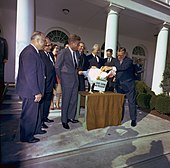
The United States observes holidays derived from events in American history, Christian traditions, and national patriarchs.
Thanksgiving is the principal traditionally-American holiday, evolving from the English Pilgrim's custom of giving thanks for one's welfare. Thanksgiving is generally celebrated as a family reunion with a large afternoon feast. Independence Day (or the Fourth of July) celebrates the anniversary of the country's Declaration of Independence from Great Britain, and is generally observed by parades throughout the day and the shooting of fireworks at night.
Christmas Day, celebrating the birth of Jesus Christ, is widely celebrated and a federal holiday, though a fair amount of its current cultural importance is due to secular reasons. European colonization has led to some other Christian holidays such as Easter and St. Patrick's Day to be observed, though with varying degrees of religious fidelity.
Halloween is thought to have evolved from the ancient Celtic/Gaelic festival of Samhain, which was introduced in the American colonies by Irish settlers. It has become a holiday that is celebrated by children and teens who traditionally dress up in costumes and go door to door trick-or-treating for candy. It also brings about an emphasis on eerie and frightening urban legends and movies. Mardi Gras, which evolved from the Catholic tradition of Carnival, is observed in the state of Louisiana.
| Date | Official name | Remarks |
|---|---|---|
| January 1 | New Year's Day | Celebrates beginning of the Gregorian calendar year. Festivities include counting down to midnight (12:00 am) on a preceding night, New Year's Eve. The traditional end of the holiday season. |
| Third Monday of January | Birthday of Martin Luther King Jr., or Martin Luther King Jr. Day | Honors Martin Luther King Jr., Civil Rights leader, who was actually born on January 15, 1929; combined with other holidays in several states. |
| Third Monday of February | Washington's Birthday | Washington's Birthday was first declared a federal holiday by an 1879 act of Congress. The Uniform Holidays Act, 1968, shifted the date of the commemoration of Washington's Birthday from February 22 to the third Monday in February. Though its formal name was never changed, many call it "Presidents' Day" and consider it a day honoring all American presidents.[54] |
| Last Monday of May | Memorial Day | Honors the nation's war dead from the Civil War onwards; marks the unofficial beginning of the summer season. (Previously May 30, shifted by the Uniform Holidays Act.) |
| June 19 | Juneteenth | Juneteenth honors the emancipation of enslaved African Americans in the United States. The word comes from "June" and "nineteenth"[55] |
| July 4 | Independence Day | Celebrates Declaration of Independence, also called the Fourth of July. |
| First Monday of September | Labor Day | Celebrates the achievements of workers and the labor movement; marks the unofficial end of the summer season. |
| Second Monday of October | Columbus Day | Honors Christopher Columbus, traditional discoverer of the Americas. In some areas it is also a celebration of Italian culture and heritage. It is celebrated as American Indian Heritage Day and Fraternal Day in Alabama;[56] celebrated as Native American Day in South Dakota.[57] In Hawaii, it is celebrated as Discoverer's Day, though is not an official state holiday.[58] |
| November 11 | Veterans Day | Honors all veterans of the United States armed forces. A traditional observation is a moment of silence at 11:00 am remembering those killed in WWI. (Commemorates the 1918 armistice, which began at "the eleventh hour of the eleventh day of the eleventh month.") |
| Fourth Thursday of November | Thanksgiving Day | Traditionally celebrates the giving of thanks for the autumn harvest. Traditionally includes the consumption of a turkey dinner, and starts the holiday season. |
| December 25 | Christmas | Celebrates the Nativity of Jesus. |
Names
The United States has few laws governing given names. Traditionally, the right to name your child or yourself as you choose has been upheld by court rulings and is rooted in the Due Process Clause of the Fourteenth Amendment of the U.S. Constitution and the Free Speech Clause of the First Amendment. This freedom, along with the cultural diversity within the United States has given rise to a wide variety of names and naming trends.
Creativity has also long been a part of American naming traditions and names have been used to express personality, cultural identity, and values.[59][60] Naming trends vary by race, geographic area, and socioeconomic status. African Americans, for instance, have developed a very distinct naming culture.[60] Both religious names and those inspired by popular culture are common.[61]
A few restrictions do exist, varying by state, mostly for the sake of practicality (e.g., limiting the number of characters due to limitations in record-keeping software).
Fashion and dress
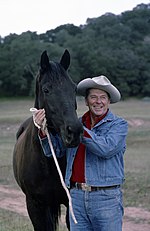
Fashion in the United States is eclectic and predominantly informal. While the diverse cultural roots of Americans are reflected in their clothing, particularly those of recent immigrants, cowboy hats and boots, and leather motorcycle jackets are emblematic of specifically-American styles.[citation needed]
Blue jeans were popularized as work clothes in the 1850s by merchant Levi Strauss, a German-Jewish immigrant in San Francisco, and adopted by many American teenagers a century later. They are worn in every state by people of all ages and social classes. Along with mass-marketed informal wear in general, blue jeans are arguably one of US culture's primary contributions to global fashion.[62]
Though the informal dress is more common, certain professionals, such as bankers and lawyers, traditionally dress formally for work, and some occasions, such as weddings, funerals, dances, and some parties, typically call for formal wear.[citation needed]
Some cities and regions have specialties in certain areas. For example, Miami for swimwear, Boston and the general New England area for formal menswear, Los Angeles for casual attire and womenswear, and cities like Seattle and Portland for eco-conscious fashion. Chicago is known for its sportswear, and is the premier fashion destination in the middle American market. Dallas, Houston, Austin, Nashville, and Atlanta are big markets for the fast fashion and cosmetics industries, alongside having their own distinct fashion sense that mainly incorporates cowboy boots and workwear, greater usage of makeup, lighter colors and pastels, "college prep" style, sandals, bigger hairstyles, and thinner, airier fabrics due to the heat and humidity of the region.
The nuclear family and family structure
Family arrangements in the United States reflect the nature of contemporary American society. The classic nuclear family is a man and a woman, united in marriage, with one or more biological children.[63] Today, a person may grow up in a single-parent family, go on to marry and live in a childfree couple arrangement, then get divorced, live as a single for a couple of years, remarry, have children and live in a nuclear family arrangement.[25][64]
Zdroj:https://en.wikipedia.org?pojem=American_pop_culture
Text je dostupný za podmienok Creative Commons Attribution/Share-Alike License 3.0 Unported; prípadne za ďalších podmienok. Podrobnejšie informácie nájdete na stránke Podmienky použitia.
Antropológia
Aplikované vedy
Bibliometria
Dejiny vedy
Encyklopédie
Filozofia vedy
Forenzné vedy
Humanitné vedy
Knižničná veda
Kryogenika
Kryptológia
Kulturológia
Literárna veda
Medzidisciplinárne oblasti
Metódy kvantitatívnej analýzy
Metavedy
Metodika
Text je dostupný za podmienok Creative
Commons Attribution/Share-Alike License 3.0 Unported; prípadne za ďalších
podmienok.
Podrobnejšie informácie nájdete na stránke Podmienky
použitia.
www.astronomia.sk | www.biologia.sk | www.botanika.sk | www.dejiny.sk | www.economy.sk | www.elektrotechnika.sk | www.estetika.sk | www.farmakologia.sk | www.filozofia.sk | Fyzika | www.futurologia.sk | www.genetika.sk | www.chemia.sk | www.lingvistika.sk | www.politologia.sk | www.psychologia.sk | www.sexuologia.sk | www.sociologia.sk | www.veda.sk I www.zoologia.sk























